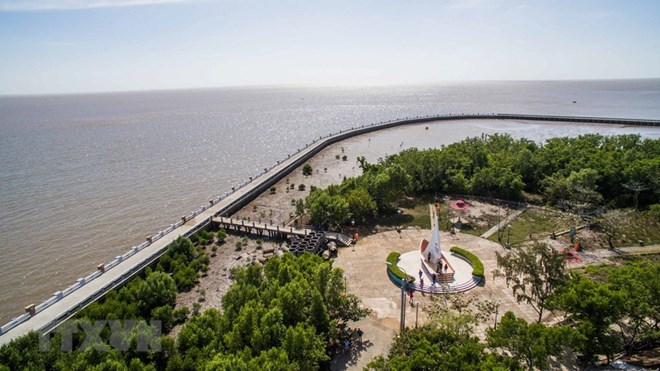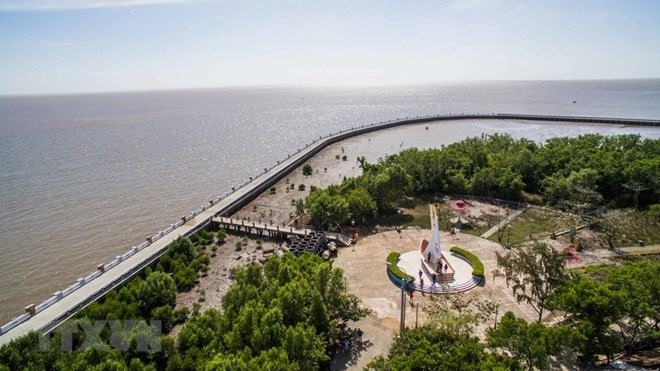



A view of
part of Ca Mau Cape tourism area (Photo: VNA)
By 2030, Ca Mau Cape tourism is expected to meet national tourism
criteria and be recognised as a National Tourism Site, according to the Prime
Minister-approved master plan for the development of Ca Mau Cape National Tourism
Site towards 2030.
Ca Mau Cape national tourism site is mainly located at Mui Village in Dat
Mui Commune of Ngoc Hien District, about 120km from Ca Mau City. It also
extends over a small part of Nam Can District.
To attract domestic tourists as the plan recommends, the site must offer
visitors options for sightseeing and exploring.
By 2025, it will begin to focus on attracting high-end tourists, with an
orientation towards resort tourism, eco-tourism and entertainment.
By 2030, high-end tourism will be the site’s priority.
For the domestic market, the Ca Mau Cape tourism site continues to focus on its
main market of visitors from HCM City, the southeast region, the
Mekong Delta provinces, Hanoi and the northern provinces.
It focuses on providing sightseeing opportunities, natural landscape
exploration and tours of the sea and islands.
For the international market, priority will be given to target markets such as
tourists from the US, Australia and northeast Asia, including
the Republic of Korea, China and Japan. At the same time, it
will seek potential markets in Western Europe,
including England and France, and Southeast Asia,
including Thailand, Laos and Cambodia.
The site is paying special attention to sea-routes and southern coastal corridors.
The tourism site will focus on tourists who want to explore the natural
landscape, experience cultural tours, visit sea resorts, ride on yachts and
enjoy entertainment.
Tourism products under consideration for development include handicrafts, tours
to experience the southernmost point of the country in combination with
watching the sunrise and sunset on the sea, explore
the Gulf of Thailand on luxury yachts, tours of the
mangrove ecosystem and an ecological experience tour at Ong Trang Hillock.
The site also hopes to focus on environmentally friendly tours that will enable
visitors to explore the area’s rich natural features.
These may include a tour along the river to observe the life of local
inhabitants and community-based tourism located at villages in Dat Mui.
Additionally, historical and cultural tours will enable visitors to
experience and research relics and the traditional revolutionary education.
The master plan indicates the functional areas of Ca Mau Cape National Tourism
Site.
The centre of the Ca Mau Cape site will be at villages of Mui, Kinh Dao Tay,
Kinh Dao Dong, Rach Tau Dongg, Rach Tho, Khai Long and at Dat Mui Commune of
Ngoc Hien District, with a total area of about 2,100 ha.
This will be the core zone with a focus on the development of the whole tourism
site with tourist works, services and entertainment centres, plus ecological
resorts in the mangrove forest.
It includes the Ca Mau Cape cultural and tourist park, sea-and mangrove forest
ecological site, community-based village ecological tourism site, farming
village-ecological tourism site and Khai Long sea tourism complex.
The investment for developing areas of special-use forest land located in the
administrative and service sub-zone and the ecological rehabilitation zone of
Ca Mau Cape must comply with the law on forest protection and development,
environmental protection and biodiversity.
The area designated for ecotourism in Dat Mui and Vien An communes, with an
area of about 3,850 ha, is adjacent to the Ca Mau Cape National Tourism Site.
It is the buffer zone and area for service centres and community-based tourism
spots.
Satellite destinations
including Nam Can Town and Rach Goc Town will
offer home-stay services, hotels, food, shopping, tourist information and
trading centres.
The ecotourism site of Hon Khoai Island will develop
sea-island ecotourism, entertainment and sea sports and historical relics. The
Dat Moi community-based tourism area will enable foreign tourists to experience
local life.
Source: VNA